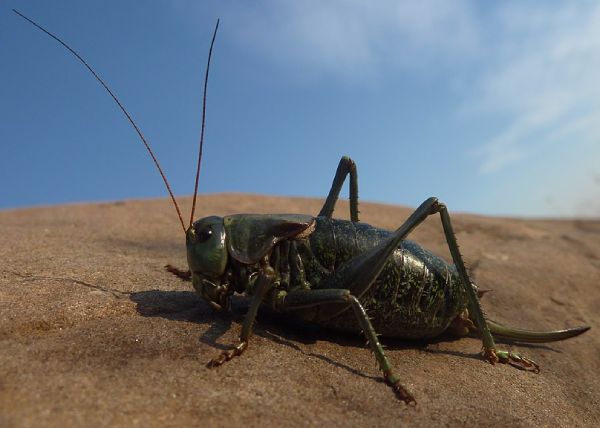Since June, mormon crickets have invaded several western states, including Colorado, Utah, Oregon and Washington, with Nevada and Idaho hit the hardest. As extreme heat baked the western United States this summer, some insect species are thriving in the hot temperatures, destroying crops and causing havoc on people's lives.
The U.S. West has been in a prolonged drought for years, which has dried up water resources and challenged farming across the region. When the heatwave hit the nation, the highest temperatures were concentrated in this region.
Experts said the insect infestations reported in the western states, such as Nevada and Colorado, were likely to be driven by global warming, an often-underestimated factor affecting the insect population.
Mormon crickets have invaded several western states since June, including Colorado, Utah, Oregon and Washington, with Nevada and Idaho hit the hardest. Elko, a town in Nevada, was infested so badly that residents compared it to a "biblical plague."
Sir Brian May, "It's not just about climate change, its about the way we are polluting the earth.. Pretty much eliminating all species except the ones we think are useful to us.. We need a major change in philosophy." @brianmaycom
— Farrukh (@implausibleblog) July 27, 2023
Professor Dante Lauretta, "When people see the… pic.twitter.com/6nnwR7g9BW
A "Cricket Patrol" was created at a regional hospital to assist patients and visitors into the building, as reported by local media Elko Daily Free Press. The patrollers used leaf blowers and brooms to clear paths for individuals.
In the past few years, farmers in the U.S. West have been battling outbreaks of Mormon crickets, which have caused crop losses. The insects devour vegetation, damaging crops and even changing patterns of erosion, water runoff and nutrient cycling, according to the U.S. Department of Agriculture (USDA).
Climate change may be partly to blame. Mormon crickets prefer both hotter temperatures and droughts. The outbreaks can follow drought conditions, as warm weather and a lack of rainfall help the insects hatch and survive, according to the Oregon state government.
In 2021, 10 million acres in Oregon, which has been especially hard-hit by the species, were destroyed by Mormon crickets and grasshoppers. In Colorado, corn earworms have infested 30 percent to 40 percent of the sweet corn crop in a major farming area this summer.
The threats posed by the worms were not new to farmers. But this year, they turned up altogether and destroyed the corn at the start of the season.
"The era of global warming has ended. The era of global boiling has arrived." pic.twitter.com/E4Rrd1a1yH
— DW News (@dwnews) July 28, 2023
Tuxedo Corn Company, the state's largest sweet corn producer, only packed about 3,000 crates per day for shipment to stores compared with three times that in a normal year. They had to leave about 400 acres of fields entirely unpicked because the worm was so pervasive.
The dire situation prompted the company and other corn farmers to seek help from the Department of Agriculture, requesting assistance from experts in sweet corn production.
Melissa Schreiner, an entomologist with the Colorado State University said that among the factors causing the corn earworm infestation was "the broiling triple-digit heat of the past few weeks."
Researchers at North Carolina State University warned that with warmer climates shifting northward, some insect species that previously would perish in the winter months may be able to survive due to warmer soil temperatures.
The trend might eventually allow the earworm to overwinter in the U.S. Corn Belt, a region whose winters have historically proven too cold for the pest, according to the research published in the Proceedings of the National Academy of Sciences in 2022.
"Climate change exacerbates the pest problem," the authors warned, "farmers can expect to face new and intense pest problems in the coming years due to the changing climate."
#FromTheSouth News Bits | The World Meteorological Organization warns that heat waves will continue until 2060. pic.twitter.com/TNc3rlVWvP
— teleSUR English (@telesurenglish) July 19, 2023





